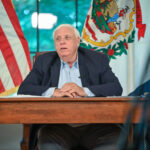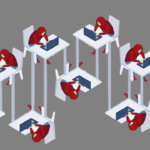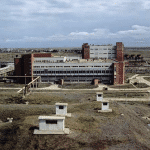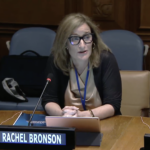Strong health care equals strong emergency response
By Laura H. Kahn | October 14, 2008
In previous columns, I’ve discussed the consequences that will result during a pandemic or bioterrorist attack from not insuring all Americans and providing adequate primary care–see “The Security Impact of the Uninsured” and “The Exodus of General Medical Physicians.” What I haven’t discussed is that the U.S. health-care system also is arguably less capable of responding to disasters when compared to nationalized health-care systems in other countries.
For example, in 1973, Britain formed a London Emergency Services Liaison Panel that required the coast guard, Royal Air Force, and ambulance, police, and fire personnel to coordinate their efforts during disaster responses. Generally, the nationalized British health-care system is well integrated with its emergency response teams. And 9/11 only galvanized the British further, as in the terrorist attack’s aftermath they established a London Regional Resilience Forum, which formed partnerships with all of the key emergency responders. (See “Preparing for Disaster: Response Matrices in the USA and UK.”) British hospital disaster-response capabilities are similarly enhanced because all of the country’s National Health Service facilities are required to be prepared for each type of disaster, and the chief executives are legally responsible for planning and training exercises.
The United States continues to maintain a fragmented hospital and health-care system that doesn’t communicate or coordinate. Simply put, it’s a set-up for failure during a disaster response.”
As such, during the 2005 London subway and bus bombings, the city’s centralized command center quickly mobilized. The Central Ambulance Control service (CAC) deployed more than 100 ambulances, and at the 33 hospitals serving the greater London metropolitan area, physicians quickly reported to work and implemented their hospitals’ major incident plans–CAC brought other physicians to the scenes of the bombings. While on site, experienced physicians trained in pre-hospital care triaged and treated the casualties. (See “The London Attacks–Response: Pre-Hospital and Hospital Care.”)
Of the 700 individuals who were injured, half needed to be brought to hospitals and half were treated at the scene. In the end, 56 people were killed, including the four suicide bombers. Given the complexity and difficulty in responding to multiple bombings and reaching victims in the subway, it’s a testament to London’s preparedness capabilities that relatively few people died.
To revamp its failing health-care system, in the late 1980s and early 1990s, Israel reorganized its Ministry of Health and established a separate National Health Authority to regulate health-care delivery. In 1994, the Israeli government passed the National Health Law, which determined that the country needed to provide universal health-care coverage to its citizens. Since then, the Ministry of Health’s key functions have included planning health-care priorities, monitoring and promoting public health, overseeing the operation of Israel’s hospitals, and preparing the health-care system for disasters such as terror or military attacks with conventional and/or nonconventional weapons. (See “Health-Care Systems in Transition: Israel.”)
Thanks to this revised health-care system, Israel has been able to develop highly coordinated and efficient emergency response systems that work in tandem with the hospitals to quickly and effectively treat the victims of the most recent Intifada, which to date has wounded more than 6,000 Israelis and killed more than 1,000 people. Its pre-hospital and hospital care is state-of-the-art—likewise for its “terror” medicine expertise. (See “Medical Lessons from Terror Attacks in Israel.”)
The United States has neither universal health-care coverage nor a nationalized health-care system. Instead, it offers a number of jumbled systems. Examples of government health insurance in the United States include Medicare, Medicaid, and the State Children’s Health Insurance Program (SCHIP). Medicare provides universal health insurance for those people 65 years of age and older; Medicaid provides some coverage for the poor; and SCHIP provides coverage to poor children. Both Medicaid and SCHIP are administered by the states, and each state has different eligibility requirements and benefits.
Every other American has to scramble to find private health insurance, which is typically offered through employment. But employees who work part-time or for small businesses are often unable to get health insurance. The end result: Millions of Americans are uninsured and without access to medical care.
Another major problem with U.S. health care is the spread of for-profit hospitals run by large corporations throughout the country. (There’s compelling evidence that such hospitals don’t provide the best patient care.) Federal, state, and local governments, religious orders, and others continue to run nonprofit hospitals. And although a 2005 Government Accounting Office report found that some government hospitals provide more uncompensated care for the poor than other nonprofit or for-profit hospitals, congressional leaders have questioned the nonprofit hospitals’ tax-exempt status since they haven’t provided enough charity care.
What we have is a fragmented hospital and health-care system that doesn’t communicate or coordinate. Simply put, it’s a set-up to for failure during a disaster response. (The United States does have a National Disaster Medical System that’s supposed to supplement and integrate state and local medical response capabilities, but it does little good when the whole system is broken.)
Given 9/11’s magnitude, it’s difficult to compare that attack to a typical suicide bombing, but there are some lessons to be learned. For instance, the 9/11 Commission found problems with the NYFD’s command and control, which hindered effective decision-making. In addition, it discovered poor communication and coordination between the NYFD, NYPD, and other emergency responders. And what little communication and coordination did occur ended after 2 World Trade Center collapsed, burying the NYFD’s command-and-control center.
Similarly, the Office of Emergency Management (OEM) was supposed to control the city’s ambulance services, but its headquarters was located in 7 World Trade Center and its communications antenna was on 1 World Trade Center. Both were destroyed. (“The World Trade Center Attack: Lessons for Disaster Management.”) Instead of having teams of physicians specialized in pre-hospital care dispatched to the scene, many well-meaning physicians dressed only in scrubs, surgical masks, and clogs began climbing over dangerous metal debris while attempting their own search-and-rescue missions. They were reprimanded and escorted away. (See “The World Trade Center Attack: Doctors in the Fire and Police Services” and “The World Trade Center Attack: The Paramedic Response: An Insider’s View.”)
Bellevue Hospital Center, a large Level 1 trauma center located 4 kilometers from the World Trade Center, received information largely by rumors rather than official means as internal and external phone lines were dead. (Since OEM’s capabilities were destroyed, there wasn’t a central command to coordinate hospitals across the city.) Therefore, Bellevue decided to prepare for the worst. The anesthesia department alone spent more than $20,000 preparing for high volumes of casualties that never came. Along with Bellevue, several other local hospitals were asked to set up and staff field hospitals near the scene. But some of the physicians these hospitals sent were post-graduate trainees with no preparation to work at field sites.
Regardless of 9/11’s scope, it’s clear that there could have been better communication and coordination between the New York City hospitals and pre-hospital emergency responders. The bottom line: The U.S. health-care system in which the hospitals function doesn’t lend itself to the inter-hospital and pre-hospital cooperation needed during disasters, making it hard to duplicate Britain and Israel’s successes without their inherent advantages.
Granted, Britain and Israel are much smaller countries. Thus, the most likely way Washington could implement a similar system would be to have states run the national program. It’s not an optimal solution, but given the geographic size of the United States and its federal system, it’s probably the best Washington could do.
However it chooses to address the issue, the United States needs to overhaul its health care and health insurance system. Hospitals should be nonprofit and run by the government, religious organizations, and/or other philanthropic entities. And U.S. hospitals must work collaboratively in order to coordinate care across regions. Also, pre-hospital care needs to be better coordinated with hospitals, and there should be teams of physicians trained in such care ready and able to mobilize at a moment’s notice. Health insurance should be nationalized, allowing basic preventive health services for diseases such as hypertension, diabetes, and high cholesterol to be available to everyone. Likewise, people should have the option to purchase additional insurance for catastrophic care.
So far, neither presidential candidate’s health-care proposals fit the bill since both futz around the edges. Republican candidate John McCain is proposing refundable tax credits for private health insurance while Democratic candidate Barack Obama’s plan includes insurance-market pooling and regulation. To get at the heart of the problem, Washington needs to decide whether or not health care is a right or a privilege. Until then, we will continue our downward spiral of spending too much for too little and not being as well-prepared for disasters as we could be.
Together, we make the world safer.
The Bulletin elevates expert voices above the noise. But as an independent nonprofit organization, our operations depend on the support of readers like you. Help us continue to deliver quality journalism that holds leaders accountable. Your support of our work at any level is important. In return, we promise our coverage will be understandable, influential, vigilant, solution-oriented, and fair-minded. Together we can make a difference.
Topics: Biosecurity, Columnists















